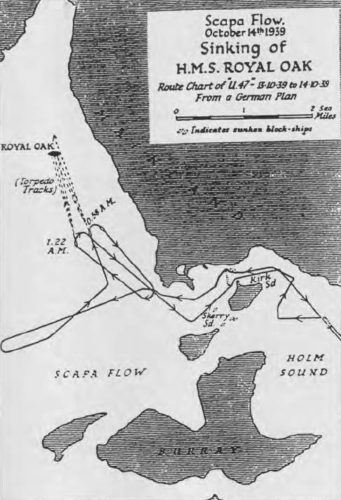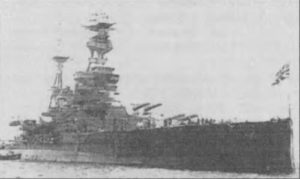- Author
- Gregory, Mackenzie J.
- Subjects
- WWII operations
- Tags
-
- RAN Ships
- None noted.
- Publication
- June 1998 edition of the Naval Historical Review (all rights reserved)
Scapa Flow in the Orkney’s was the main Fleet Anchorage in the British Isles for the Royal Navy.

Route Chart 11:47 to 14:10:39
During World War I, the German Submarine UB-116 commanded by Oberleutnant Hans Joachim Emsmann had, in October, 1918, attempted to penetrate this British Base but had come to grief on a mine and was lost with all hands.
Just after going to war against Britain in 1939 the German U-Boat Commander, Admiral Dönitz, was keen to upset the Royal Navy and her First Lord of the Admiralty, Winston Churchill, by breaching the defences of Scapa Flow and sinking a major naval vessel.
In September 1939 U-14 had carried out a patrol in that area and brought back valuable information about the approaches to this Fleet Base. In addition the Luftwaffe, on the 26th of September, had managed to obtain excellent photographs of this seemingly impregnable anchorage. At least the British believed it was inviolable; but not so, thought Dönitz.
The defences of Britain’s major naval base were still not complete 6 weeks after the commencement of hostilities with Germany.
Dönitz studied- the reconnaissance photographs and decided that a 50 foot gap existed between the blockships which had been sunk in the northern end of the most eastern entrance in Kirk Sound, and he believed that a surfaced U-Boat could penetrate this narrow access at the time of slack water.
A night attack would be mandatory.
On Sunday the 1st of October, 1939, Dönitz sent for one of his best submarine captains, Kapitanleutnant (equivalent to our Lieutenant Commander) Gunter Prien, and offered him the mission of taking his U-Boat U-47 into Scapa Flow to sink a major British warship. Prien had been born at Leipzig in Saxony in 1909, and left school at 14 to become a cabin boy at sea.
He rose to be a Merchant Marine officer, but come the Depression he was out of a job. Somewhat embittered by being unemployed in his early twenties, Prien joined the Nazi Party in 1932, and in the following year joined the Navy as an Ordinary Seaman. He was quickly seen as officer material, became a cadet, joined the submarine service and rose to command level by 1938. Prien was in command of U-Boat 47 when war broke out. He had only recently married.
It was made quite clear to Prien that he could refuse this task without damaging his bright career, but Prien after studying the plans overnight, decided to accept this formidable challenge.
On the 8th of October, 1939, Prien took U-47 through the Kaiser-Wilhelm-Kanal and cleared her into the North Sea. Whilst enroute to Scapa Flow he took particular care to avoid any vessels that could betray his whereabouts. At 2331 on the 13th October (obviously not a superstitious sailor) Prien started his run into the British Naval stronghold.
Because of the strong currents obtaining in this area, he chose the slack water period between tides, and navigated his boat on the surface between vessels sunk in the channels, by the British, designed to stop such an attack.
At one stage of Prien’s approach he was so close to the shore that a passing car’s headlights illuminated his submarine; but his luck held, and he continued undetected. Just after midnight on the 13/14 of October, he noted in his War Diary at 0027 “Wir sindin Scapa Flow!!!” (“We are in Scapa Flow!!!”)
For the Royal Navy it was fortunate that the major units of the Home Fleet had not yet returned to Scapa Flow after chasing a strong German Naval Force, led by the battle cruiser Gneisenau, which had sortied out into the North Sea.

“Royal Oak” was the second largest ship sunk in the war by a German U-Boat.
Inside the anchorage Prien looked for likely targets and sighted 2 large ships to his north. At 0058 he fired a spread of 3 torpedoes and after 3.5 minutes, one explosion was heard. Prien was pleasantly surprised when it did not appear to attract any attention from the British.
